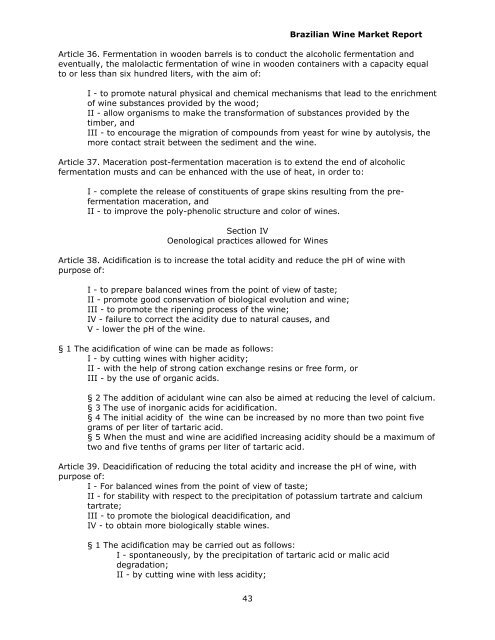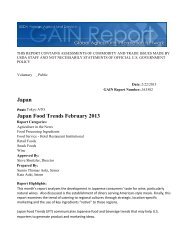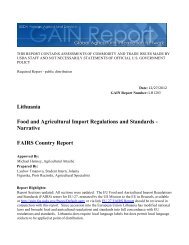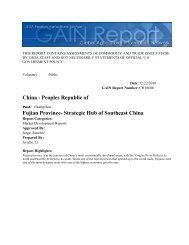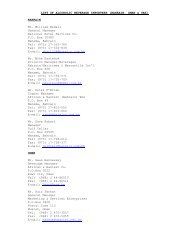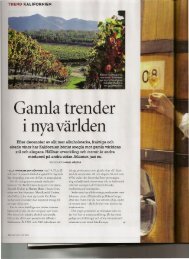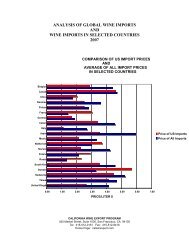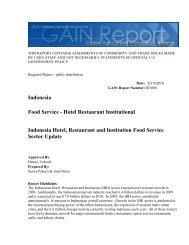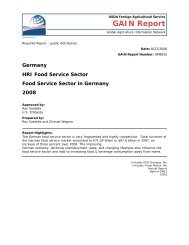Brazil Wine Market Report JBC EMP July 2011 - California Wine ...
Brazil Wine Market Report JBC EMP July 2011 - California Wine ...
Brazil Wine Market Report JBC EMP July 2011 - California Wine ...
You also want an ePaper? Increase the reach of your titles
YUMPU automatically turns print PDFs into web optimized ePapers that Google loves.
43<br />
<strong>Brazil</strong>ian <strong>Wine</strong> <strong>Market</strong> <strong>Report</strong><br />
Article 36. Fermentation in wooden barrels is to conduct the alcoholic fermentation and<br />
eventually, the malolactic fermentation of wine in wooden containers with a capacity equal<br />
to or less than six hundred liters, with the aim of:<br />
I - to promote natural physical and chemical mechanisms that lead to the enrichment<br />
of wine substances provided by the wood;<br />
II - allow organisms to make the transformation of substances provided by the<br />
timber, and<br />
III - to encourage the migration of compounds from yeast for wine by autolysis, the<br />
more contact strait between the sediment and the wine.<br />
Article 37. Maceration post-fermentation maceration is to extend the end of alcoholic<br />
fermentation musts and can be enhanced with the use of heat, in order to:<br />
I - complete the release of constituents of grape skins resulting from the prefermentation<br />
maceration, and<br />
II - to improve the poly-phenolic structure and color of wines.<br />
Section IV<br />
Oenological practices allowed for <strong>Wine</strong>s<br />
Article 38. Acidification is to increase the total acidity and reduce the pH of wine with<br />
purpose of:<br />
I - to prepare balanced wines from the point of view of taste;<br />
II - promote good conservation of biological evolution and wine;<br />
III - to promote the ripening process of the wine;<br />
IV - failure to correct the acidity due to natural causes, and<br />
V - lower the pH of the wine.<br />
§ 1 The acidification of wine can be made as follows:<br />
I - by cutting wines with higher acidity;<br />
II - with the help of strong cation exchange resins or free form, or<br />
III - by the use of organic acids.<br />
§ 2 The addition of acidulant wine can also be aimed at reducing the level of calcium.<br />
§ 3 The use of inorganic acids for acidification.<br />
§ 4 The initial acidity of the wine can be increased by no more than two point five<br />
grams of per liter of tartaric acid.<br />
§ 5 When the must and wine are acidified increasing acidity should be a maximum of<br />
two and five tenths of grams per liter of tartaric acid.<br />
Article 39. Deacidification of reducing the total acidity and increase the pH of wine, with<br />
purpose of:<br />
I - For balanced wines from the point of view of taste;<br />
II - for stability with respect to the precipitation of potassium tartrate and calcium<br />
tartrate;<br />
III - to promote the biological deacidification, and<br />
IV - to obtain more biologically stable wines.<br />
§ 1 The acidification may be carried out as follows:<br />
I - spontaneously, by the precipitation of tartaric acid or malic acid<br />
degradation;<br />
II - by cutting wine with less acidity;


